5+ Sample Subcontractor Safety Plan
-
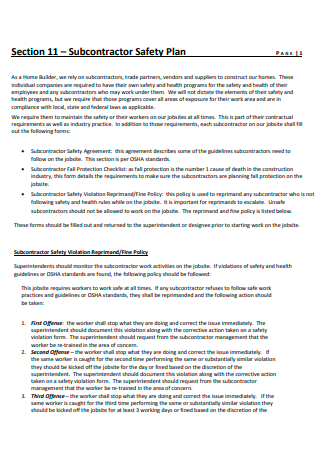
Subcontractor Safety Plan Template
download now -
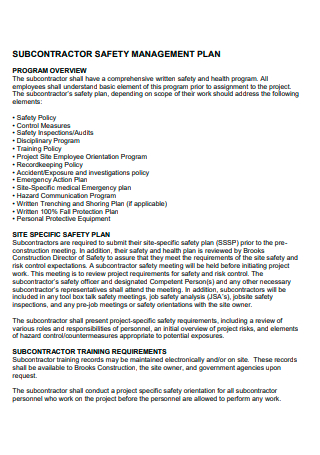
Subcontractor Safety Management Plan
download now -
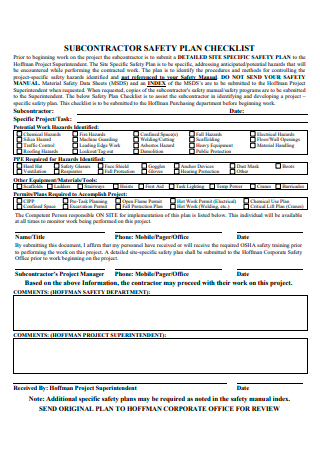
Subcontractor Safety Plan Checklist
download now -
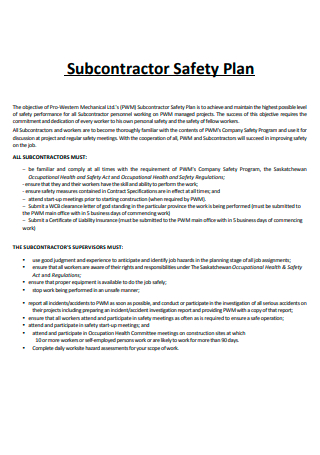
Subcontractor Safety Plan in PDF
download now -
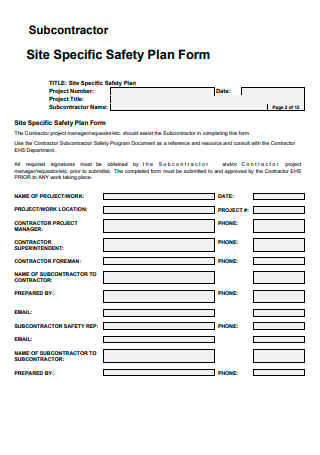
Subcontractor Site Safety Plan Form
download now -
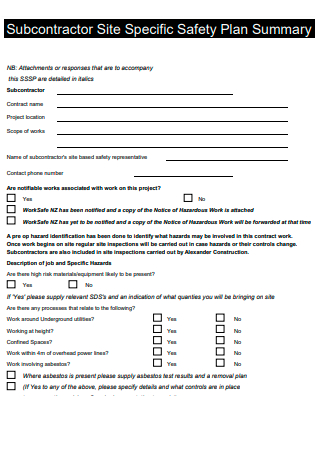
Subcontractor Site Specific Safety Plan Summary
download now
FREE Subcontractor Safety Plan s to Download
5+ Sample Subcontractor Safety Plan
What Is a Subcontractor Safety Plan?
Elements of a Subcontractor Safety Plan
Steps in Writing a Subcontractor Safety Plan
FAQs
What exactly are the three E’s of safety?
How do a contractor’s role and obligations differ?
What factors contribute to the failure of some site-specific safety plans?
What Is a Subcontractor Safety Plan?
Safety plans are written documents that provide a defined and detailed framework for workplace safety measures. They are also known as risk management plans. Workplace safety plans are tailored to a specific activity or department inside the organization. In order to ensure that all operations are carried out to the greatest possible standard, a subcontractor safety plan mixes together information regarding health, safety, and environmental management to build a cohesive whole. It is common for this type of quality assurance to be successful, particularly for major organizations, because it gives project managers a technique that they can use to incorporate subcontractor management into their overall subcontractor management activities. Then you may create a policy that will consistently classify and manage your health and safety activities and obligations, allowing you to be more productive. A set of standards is established in any large organization, and these standards are applied to all of the subcontractors. The compliance with or assessment of their alignment with the organization’s code of conduct, financial history or credibility, competitive market pricing, competency certification or quality assurance, adherence to health and safety management standards, security standards, projector performance management, and a variety of other considerations are all taken into account. Each of the project managers will be able to take on additional management responsibilities that will be determined by the specific criteria applicable to their respective regions. Based on the requirements of the project, each portion of the defined criteria will be given equal weight in the evaluation process.
If you require another theme, we have a number of others available on our website that you can use at any time. The names of these individuals are as follows: The templates available include a Portfolio Management Plan, a Shared Services Agreement, a Human Resources Change Management Plan, subcontractor management plan, a Subcontractor Statement, a Standard Subcontractor Agreement, contractor safety plan, a Project Budget Proposal, project action plan, and other forms of documentation. The content in this post is not only about templates, but it also provides important information that you should be aware of in order to effectively create your template.
Elements of a Subcontractor Safety Plan
In order to effectively manage your business connection with the subcontractor that you have selected for the job, it is vital to develop a subcontract safety plan. It is possible to put together a strategy for implementing the agreement by following the instructions provided in the template provided below. It is vital that you follow the three recommended processes listed below in order to develop an effective subcontractor safety plan:
Steps in Writing a Subcontractor Safety Plan
In a basic subcontractor safety plan, each component is written in succinct and professional language, and each component includes a number of standards that must be met in order for the plan to be effective. Sublease statement The provisions should be presented in a comprehensible and succinct manner in order to limit the possibility of future misinterpretation or ambiguity. This is explained in greater detail in the next section. It is anticipated that as a result of this clarity, all parties that agree to the terms of the subcontractor safety plan will be legally protected from one another. The following are the stages that must be completed during the development of a standard subcontractor safety plan, which is given in descending order of significance:
Step 1: Define the Scope of the Project
The work that will be completed, as well as the overall scope of the project, are all specified in detail in this portion of the agreement. Client standards, subcontractor responsibilities, and your own expectations as a contractor are just a few of the aspects taken into consideration. Please also examine our business action plan, which may be found here.
Step 2: Estimate When the Project Will be Completed.
The statement will describe how much more time you will allocate to subcontractors in order for them to perform their responsibilities on time and according to your specifications. A deadline set several weeks ahead of your own ensures that you will have the time to check and evaluate the work completed by your subcontractor before it is deemed complete and finalized. Having confidence that the work will be of high quality brings comfort to both you and the client. You should also take a look at our business emergency action plan.
Step 3: Collect payment and Billing Information
The amount of money that the subcontractor received for the task that they accomplished is explained in detail in this section. It will be determined how much the subcontractor will be compensated based on the scope of the job performed by the company. Extensions, as well as any Longer Payments, should be indicated in the contract if the subcontractor requires additional time to perform all of the tasks that have been assigned to him or her. In addition, you should review our Staffing Management Plan.
Step 4: Responsibility in the Event of an Accidental Damage Claim.
In the event of an accident-related damage claim, the fourth step is to determine responsibility. If you have insurance coverage for errors, omissions, or accidental damage caused by the subcontractor’s employees, it is possible that you will be covered or that you will not be covered. In the event that you have insurance, you must complete this section and supply all of the required information. It is also the insurance provider’s responsibility to explain to the client what his or her insurance responsibilities are in the event this is not the case.
Step 5: Complete and Submit Your Assignment.
Specific restrictions and authorizations that apply to the subcontractor’s hiring of additional workers to help them in carrying out their assignment under the terms of this section of the agreement may be stipulated with great clarity in the agreement. In the construction industry, it is common practice to impose restrictions on your contracted subcontractor in order to prevent spreading the line of work’s obligations too widely across the entire project. “Line of work constraints” is what this is referred to as.
Step 6: Guarantees and Warranties
If you provide assurances to the subcontractor, this section must include any assurances provided to you by the subcontractor as well as any assurances provided to the subcontractor by you. If you do not provide assurances to the subcontractor, this section must include any assurances provided to you by the subcontractor. As a result, you will need to hire subcontractors to execute all or a portion of the work required to effectively complete your client’s project on time and on budget. Most commonly, subcontractor agreements should specify the subcontractor’s obligations, responsibilities, and tasks, in addition to any other terms or conditions that have been agreed upon by both parties prior to the signing of the agreement.
FAQs
What exactly are the three E’s of safety?
Engineering, enforcement, and education are the three E’s of workplace safety: engineering, enforcement, and education.
How do a contractor’s role and obligations differ?
Building permit applications, property security, temporary utility installation on the Jobsite, personnel management on the Jobsite, site surveying and engineering, disposal or recycling of construction waste, and monitoring of project schedules are all responsibilities that fall under the purview of a contractor.
What factors contribute to the failure of some site-specific safety plans?
In some cases, a safety plan fails because the details in it do not address specific challenges that are unique to a particular location. For example, the safety plan may fail to take into consideration project features, such as the site layout, which might have an impact on the overall safety of all personnel on the project. This document may also omit critical information such as any potentially hazardous chemical components that will be used in the project, and an accurate visual diagram of the site, or critical details about the worksite’s location that will have an impact on the construction work that is being done there.
Prevent any grammatical or factual errors from appearing in the final copy of the safety plan that will be used to orient your workers and other contractors during the course of the task on the construction site before printing it. You may want to get the assistance of a coworker throughout the editing phase to verify that no elements are overlooked and that your safety plan is properly organized to make it appear professional. Download our free sample templates above and use them as a reference to help you get started on drafting your safety plan.
